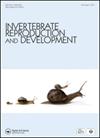Gonadal development, reproductive investment and fecundity of Aegla castro Schimitt, 1942 (Crustacea, Anomura)
IF 0.8
4区 生物学
Q4 REPRODUCTIVE BIOLOGY
引用次数: 3
Abstract
ABSTRACT Aegla castro, is an endemic anomuran crab from Brazil found in headwater streams of the Atlantic Forest on the Paranapanema River basin. This study aims to evaluate the gonadal maturity of A. castro based on macroscopic and microscopic analyses. Crabs were collected in Mauá da Serra (23º57’ S; 51º06ʹ W), Paraná, Brazil in the winter and spring of 2015, and summer, autumn, and spring of 2016. Individuals had their gonads analysed and categorized into stages of development. Stage1, ovaries are macroscopically undetectable through abdominal transparency, while ovaries of stages 2 and 3 could be detected through abdominal transparency and have characteristic colour and length in relation to the abdominal somites. Ovaries have pre-vitellogenic and vitellogenic oocytes in all stages of development, with germ cells and structural epithelium characteristic of these gonadal maturation phases. Spermatogenesis in males begins in spring, with the production of spermatozoa in autumn and spermiation in winter. Aegla castro has seasonal reproduction. The macroscopic stages of gonadal development correspond to the histological gonadal maturation, indicating that the macroscopic observation of the gonads of live animals is feasible in studies of the reproductive cycle of aeglids.虾蛄的性腺发育、生殖投资和繁殖力,1942(甲壳纲,野村目)
卡斯特罗蟹是一种巴西特有的异常蟹,发现于帕拉纳帕内玛河流域大西洋森林的源头溪流中。本研究旨在通过宏观和微观分析来评价卡斯特罗的性腺成熟度。螃蟹采自mau da Serra(23º57’S);2015年冬季和春季,以及2016年夏季、秋季和春季,在巴西帕拉南(51º06′W)。研究人员对个体的性腺进行了分析,并将其分为不同的发育阶段。第1期卵巢通过腹部透明无法在宏观上检测到,而第2期和第3期卵巢通过腹部透明可以检测到,并且具有与腹部体相关的特征颜色和长度。卵巢在发育的各个阶段都有卵黄前卵母细胞和卵黄前卵母细胞,生殖细胞和结构上皮具有性腺成熟阶段的特征。雄性的精子发生始于春天,秋天产生精子,冬天受精。卡斯特罗有季节性繁殖。性腺发育的宏观阶段与性腺成熟的组织学阶段相对应,说明活体动物性腺的宏观观察在卵形纲生殖周期研究中是可行的。
本文章由计算机程序翻译,如有差异,请以英文原文为准。
求助全文
约1分钟内获得全文
求助全文
来源期刊
CiteScore
1.90
自引率
0.00%
发文量
21
审稿时长
>12 weeks
期刊介绍:
Invertebrate Reproduction & Development ( IRD) presents original research on the reproductive and developmental biology of the Invertebrata, both embryonic and postembryonic. IRD welcomes papers reporting significant results obtained using new techniques. Encouraged topic areas include: aquaculture, physiology, biochemistry, functional morphology, phylogeny, behavioural and regulatory mechanisms, including genetic, endocrine and molecular studies. Papers containing qualitative descriptions of reproductive cycles and gametogenesis will not be considered. IRD is published in association with the International Society of Invertebrate Reproduction and Development.

 求助内容:
求助内容: 应助结果提醒方式:
应助结果提醒方式:


